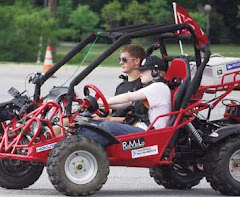The following is my May, 2010 column From Where I Sit for Voices of Central Pennsylvania:
Imagine racing a Ferrari F430 (worth $406,000) at nearly 182 miles per hour and being blind since the age of three. This event took place last month at an airport in Turkey where Metin Fenturk, a folksinger, broke the Guinness “world record for fastest unaccompanied blind driver” previously held by a British manufacturer. On winning, Fenturk said, “I don‘t knowi there are any words to describe this feeling. I am completely happy. It was really hard, like a dance with death:” [See http://voicesweb.org/driving-blind]
On a less-than-pedestrian note, Virginia Polytechnic Institute and State University(Virginia Tech) has made a major contribution to the National Federation of the Blind (NFB) challenge: Design an automobile for an individual who is totally blind to drive safely to and from work by oneself. “Can you imagine a blind person behind the wheel of a car?” the narrator of a video produced by Virginia Tech asks. “Well today it may not be long before you won’t need to imagine.” Virginia Tech’s vehicle was driven by a person who is totally blind and successfully passed a parking lot driving course of considerable complexity.
Virginia Tech’s Steven Mackay, at the engineering college, told me this month two Ford Hybrids are arriving to be retrofitted for people who cannot see. I have been trying frantically to understand the intricacies involved with this technology. My mind is overflowing with technical details I do not yet understand. Meanwhile, Mackay’s clear explanation will have to suffice:
“This laser sensor, mounted on the front of the…vehicle, operates similar to sonar. It sends out a laser beam that will bounce back to the device as it hits an obstacle. The sensor then figures out the distance to the obstacle by measuring the time of flight of the laser beam. As the laser sweeps the environment, the computer constructs a map of all obstacles around the vehicle.”
Here in State College, a discussion with Cary Supalo provides context to encouraging developments for career training for blind students and how Virginia Tech technology energized an NFB science camp when camp members lined up eagerly for their turn to drive. Supalo is president of the local chapter of the NFB, but he is best known for his Penn State career in chemistry. Supalo has a master’s degree on the subject at Penn State and is expected soon to obtain a doctorate and a job as a professional chemist.
Supalo‘s work to encourage blind children to take math, science and engineering courses has been exceptional. As someone who has recently begun a job [technically “a job training program” with the opportunity of a permanent position], I look with hope to Supalo’s lead.
My job for the Altoona-based Blair/Clearfield Association for the Blind is to find jobs for people who want to work but cannot see. Most people who are blind in Altoona and want work do not have the educational background to do anything but themost menial work. Altoona has a surplus of “able-bodied” u n e m p l o y e d workers who can’t find work. On the order of the ladder, in these still difficult economic times, people with disabilities are at the bottom. The immediate solution is to work to improve the economic situation as a whole throughout central Pennsylvania. As the expression goes, “All boats rise with a high tide.”
Meanwhile, the orchestration of Virginia Tech’s successful test has Supalo’s handwork written all over it. Supalo is an energetic leader. When I visited Supalo’s office, he was developing professionally required tests a blind chemist can perform independently. Supalo, who is charming and astoundingly energetic, comes closer to anyone I have met to having the charisma to lead the emerging disability rights movement—a movement that badly needs leaders.
The Jernigan Research Institute wrote the following about Supalo: “His loves are helping blind students expand their comforzones, assisting them to stretch their minto go beyond societal limitations placed on
them since birth and encouraging them to strive to follow their dreams.”
The best job a disabled person can have is one that is part of a career— well-paid, stable, leading to advancement and providing profession rewards. Our disability community through central Pennsylvania must work vigorously to change our area’s education system so students graduate from high school after mastering basic requirements so becoming a scientist is an achievable goal. As a society, we are wasting the talent of the physically disabled whatever their individual career goals. This waste is not only a crime; it is bad for the economy.
Monday, May 3, 2010
Subscribe to:
Post Comments (Atom)





I think that the rehabilitation centers and schools for the blind need to sit down with engineers and develop this car and also develop universally designed cash registers and other technology that is used in real world stores and restaurants like Best Buy, Papa Gino's, McDonalds and so on. Not just mandate chorus.
ReplyDeleteI think that the rehabilitation centers and schools for the blind need to sit down with engineers and develop this car and also develop universally designed cash registers and other technology that is used in real world stores and restaurants like Best Buy, Papa Gino's, McDonalds and so on. Not just mandate chorus.
ReplyDelete